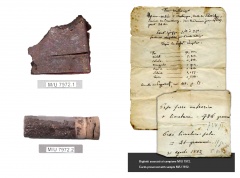(Unless otherwise stated, the copyright of the materials included belong to Jan Woreczko & Wadi.)
Szablon:TurinIMM
Z Wiki.Meteoritica.pl
m |
m |
||
| Linia 39: | Linia 39: | ||
Charakterystyczne muzealne etykiety towarzyszące okazom | Charakterystyczne muzealne etykiety towarzyszące okazom | ||
| - | <gallery caption="" widths=" | + | <gallery caption="" widths="240px" heights="240px" perrow="3"> |
File:Labels_(Costa_2018).jpg|Etykiety (od góry): Alfianello{{MBD-record|name=Alfianello}}, Canyon Diablo{{MBD-record|name=Canyon Diablo}}, [[Mocs]], Toluca{{MBD-record|name=Toluca}} | File:Labels_(Costa_2018).jpg|Etykiety (od góry): Alfianello{{MBD-record|name=Alfianello}}, Canyon Diablo{{MBD-record|name=Canyon Diablo}}, [[Mocs]], Toluca{{MBD-record|name=Toluca}} | ||
</gallery> | </gallery> | ||
Aktualna wersja na dzień 18:45, 30 lis 2024
Uniwersytet w Turynie, Włochy (Museo Regionale di Scienze Naturali (former: Istituto Mineralogia, Facoltá di Scienze, Universita di Torino); Turin, Inst. Min. Mus.) – ● [katalog → Costa et al. (2018)]
Galerie
Okazy z kolekcji (źródło: Costa et al. 2018)
Płytka (205,7 g) meteorytu Seeläsgen |
Płytka (706,1 g) i fiolka (19,52 g) z fragmentami meteorytu Seeläsgen |
Opisy fragmentów meteorytu Seeläsgen:
The Historical Numerical Catalogue of the Mineralogical Collection reports, for the three samples, the locality: «Seeläsgen, Brandeburgo, Schwiebun district, Prussia».
Along with sample M/U 7972.1, an old paper tag is still preserved, it is handwritten in India ink and reports «Fer méteorique / Masse tombée a Seeläsgen, Cercle de Schwielum, Province de Brandbourg, dans le dernier jour de 8bre 1847, pesant 218 liv. / Meteoric iron – Mass fallen at Seeläsgen, Schwiebun district, Brandbourg province, the last day of October 1847, weight 218 pounds». In the tag it is thus specifically reported a fall date (1847), which is also reported in the Historical Alphabetical Catalog as well as in the Historical Numerical Catalog of the Mineralogical Collection. In literature some authors report that the meteorite was found in 1847, whereas other authors specify that in 1847 it was recognized the extra-terrestrial nature of the sample, which was actually found years before (Buchwald, 1975). Indeed, the Meteorites Catalog of the Mineralogical Museum corrects the previous notes with the integration: «olosidera, known as meteoric iron from 1847 (before, it was confused with other stones in a rock wall)».
Furthermore, the same paper tag reports that the meteorite was analysed in May 1948, enclosing also the results.
From this specimen, on May 12th 1882, a 116 g fragment was detached and given to L. Eger[1] (Vienna, Austria), obtaining in return a sample of native iron from Ovifak[2] (Qeqertarsuaq Island, Greenland). Other tags are also preserved (dating back to the first years of the XX century) reporting analytical results and notes on the interventions on the sample. The Catalog number of the Mineralogical Collection, handwritten on the sample, is today partly faded because of oxidation.
Sample M/U 7972.2 is constitued by a glass vial containing 19.52 g of iron filings obtained by cutting the fragment of 116 g used for the exchange with L. Eger (Vienna, Austria). A label, dated August 31st 1895, is preserved with the specimen; it is handwritten by G. Spezia[3] (Head of the Museum of Mineralogy of Turin) and lists the weights of the original fragments. The list was thereafter modified by Spezia himself.
Data for both M/U 7972 specimens and for sample M/U 8094 are reported in the Meteorites Catalog of the Mineralogical Museum. On the latter is visible the Catalog number carved on the sawed surface.
Dwa okazy (104,4 i 32,6 g) meteorytu Pułtusk |
Opisy okazów meteorytu Pułtusk:
The samples were probably acquired from Krantz Company (Bonn, Germany).[4] Both fragments include old tags reporting the finding area (Pultusk), the fall date and the weight. The Meteorites Catalog of the Mineralogical Museum reports: «fragments of the aerolite fallen on January 30th at 7 p.m., in Sielec and Gostkowo near Pultusk». The total weight of the fragments, measured in 1891, was 137 g.
The old labels enclosed to sample M/U 10008.1, probably prior to the Meteorites Catalog of the Mineralogical Museum, indicate a weight of 112 g.
Last revision of chemical features and classification was conducted by Prof. G.O. Iancu (Iasi University, Romania) in November 2004.[5]
Charakterystyczne muzealne etykiety towarzyszące okazom
Bibliografia
- Costa Emanuele, Marengo Alessandra, Bittarello Erica, Gallo Lorenzo Mariano, (2018), Le Meteoriti del Museo di Mineralogia e Petrografia dell’Università e del Museo Regionale di Scienze Naturali di Torino, Torino 2018, ss. 251.[9] Plik PDF.
- Koblitz Jörn, MetBase. Meteorite Data Retrieval Software, Version 7.3 (CD-ROM), Ritterhude, Germany 1994-2012. MetBase.
Przypisy
Zobacz również
- meteoryty: Pultusk (Pułtusk), Seeläsgen (Przełazy)



